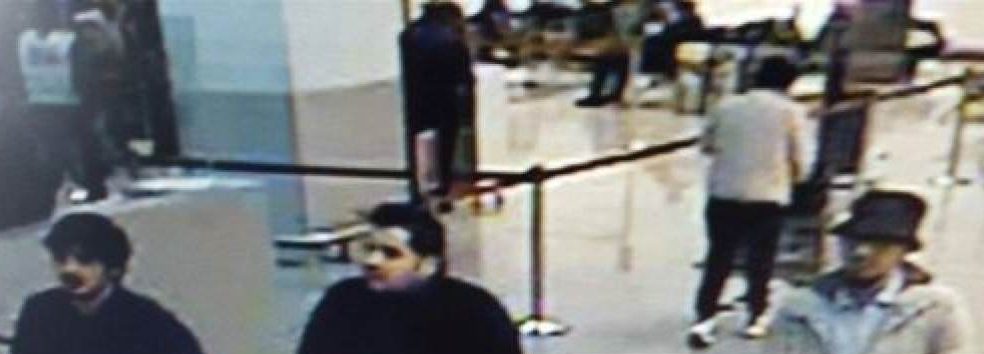-

-
Wikirise.com Advertise with Us HereStats: 4,783 members, 41,615 Posts
Number of Comments : 2,630
Date: Sunday, 24th November 2024
The 2016 Brussels attacks: Belgium’s day of terror
By Godwin Emmanuel - September 10, 2022 | Categories: World Tags: Crime
Share this post:
On the morning of March 22, 2016, Islamic State suicide bombers struck Brussels airport and metro, killing 32 people and injuring hundreds in the symbolic heart of Europe.
On Monday, a Brussels court will hold preliminary hearings in the trial of 10 people accused of the worst attacks in Belgium’s post-war history, including Salah Abdeslam, the so-called “10th man” of the November 2015 Paris attacks.
Ahead of the hearings, AFP looks back at how the events unfolded:

(FILES) This file image released on March 22, 2016, by the belgian federal police on demand of the Federal prosecutor shows a screengrab of the airport CCTV camera showing suspects of the morning’s attacks at Brussels Airport, in Zaventem. – Preliminary hearings in the trial of the March 22, 2016, jihadist attacks in Brussels open on September 12, 2022. The Brussels court of assizes begins its work with a hearing scheduled for one day to settle procedural issues, but where nine defendants are already expected, including the French jihadist Salah Abdeslam. A tenth, presumed dead in Syria, will be tried in his absence. The Brussels attacks were committed by the same jihadist cell as those of November 13, 2015 in Paris, which killed 130. They were also claimed by the Islamic State organisation. Three men blew themselves up, two at the airport and another in the metro, injuring hundreds in addition to the 32 dead. (Photo by – / BELGIAN FEDERAL POLICE / AFP)
– Twin airport blasts –
It’s just before 8 am, and hundreds of people are waiting to check in at Brussels international airport when three men arrive at the airport by taxi.
CCTV footage shows them walking side by side through the departures hall, pushing trolleys carrying bags packed with explosives.
Two of them appear to be wearing black gloves on their left hand, which experts suspect were used to conceal detonators.
The third man, who is wearing a hat and glasses, leaves his bag on the floor and flees the scene just before the attacks.
At 7:58 am, the first suicide bomber, Ibrahim El Bakraoui, who had tried to travel to Syria but had been deported by Turkey, detonates his bomb.
Nine seconds later, the second attacker, IS bomb-maker Najim Laachraoui, triggers his explosives, which cause a more powerful blast.
The explosions shatter the terminal’s windows and cause part of the roof to fall in.
Belgian television footage later showed a lone baby left sitting crying in the wreckage next to the lifeless body of a woman.
The 16 victims include Peruvian Adelma Marina Tapia Ruiz, whose husband and three-year-old twin daughters survived because the girls had run off and their father was chasing after them.
Shortly after the arrival of the bomb disposal squad, the bag left behind by the third man, identified weeks later as Mohamed Abrini, explodes by accident.
It contains more explosives than the two others but no one is injured.
– Metro massacre –
At 9:11 am, as news of the airport attack reverberates around the city, a blast rocks Maelbeek metro station, which is close to the main EU institutions.
Khalid El Bakraoui, the younger brother of the first airport bomber and who is wanted over his links to the attackers in Paris, has just detonated his bomb on a train.
Sixteen more people are killed. Many nationalities are among the victims.
“I’m fine, don’t worry, it’s horrible,” a woman says on her phone as she leaves the scene with tears in her eyes.
– IS claims responsibility –
That afternoon, the Islamic State (IS) group claims responsibility for the attacks, citing Belgium’s role in the US-led alliance fighting IS in Syria and Iraq.
The assaults trigger an outpouring of solidarity, with leaders around the world sending condolences.
Throughout the day, hundreds of people gather on the Place de la Bourse in the historic old town centre of Brussels to leave flowers, candles, and messages.
Prime Minister Charles Michel addresses the country in its “dark moment” and joins the crowd along with European Commission President Jean-Claude Juncker.
– Manhunt –
At the apartment block in the Schaerbeek neighbourhood of Brussels, from where the three attackers set out for the airport, police discover a bomb-making factory containing fifteen kilos of explosives, as well as chemicals, detonators, a suitcase full of nails and other equipment.
In a bin outside, investigators find a computer that contains a message left by Ibrahim El Bakraoui, in which he said he was rushing into action because police were hunting him and he did not want to end up in a jail cell.
It also contains messages from Abdeslam, who had been arrested four days earlier in Brussels, and photos of members of the jihadist cell posing in front of an are flag.
On April 8, investigators arrest Abrini and another suspect, Osama Krayem, who had accompanied Khalid El Bakraoui to Maelbeek metro station but did not get on the train.
The pair are among several suspects in the Brussels attacks, including Abdeslam, who are convicted over the Paris attacks in June 2022 and who now faces a second trial in Belgium.